Seo criomag audio / here’s an audio-clip (Gaelic):
Seo criomag audio / here’s an audio-clip (Gaelic):
STORIES, MUSIC AND SONG
RELATING TO THE FISHING AND LIFE IN THE SEABOARD
SPECIAL GUESTS
KATIE ROSS
HANSY SUTHERLAND
(sharing memories of how it was)
DAVINE SUTHERLAND
MAUREEN ROSS
(performing songs relating to the fishing)
SCOTT MURRAY
(of the ‘Sangsters’)
Performing songs of the East Coast Fishing Communities
SEABOARD MEMORIAL HALL
SATURDAY 15th OCTOBER
7.00PM
Tickets £3.00
Refreshments served during interval
Your support will be appreciated
NY2SY on Tour
Sat 8th Oct – STORNOWAY (Perceval Square)
Mon 10th Oct – INVERNESS (Falcon Square)
Tues 11th Oct – ABERDEEN (St.Nicholas St)
Wed 12th Oct – PERTH (The Plaza, beside Perth Concert Hall)
Thurs 13th Oct – EDINBURGH (Castle St pedestrian area, just off Princes St.)
Fri 14th Oct – GLASGOW (Buchanan St., by Donald Dewar statue)
I will be present from 10am – 6pm, please come along and see the boat 🙂
Hope to see you somewhere, sometime!


Mnathan nan Iasgairean / Fishermen’s Wives
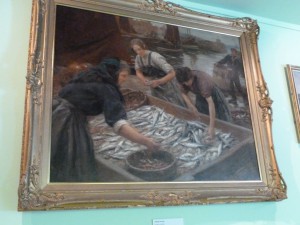 Nuair a bha mi ag ullachadh buth-obrach mu bhailtean iasgaich san Ear-Tuath bliadhna no dhà air ais (sgrìobh mi ma dheidhinn anns na Seaboard News aig an àm sin), bha mi a’ rannsachadh òrain freagarrach, agus mhothaich mi gu bheil iomadh òran ann a tha a’ dèiligeadh ri beatha nam boireannach, m.e. mnathan nan iasgairean is na caileagan-sgadain. Na làithean seo bha mi a’ bruidhinn mu dheidhinn sin ri mo mhàthair cuideachd, as dèidh dhuinn a bhith anns an East Neuk ann am Fìobha agus gu h-àraidh ann an taigh-tasgaidh iasgaich ann an Ànsruthair, leis na taisbeanaidhean agus na dealbhan a tha a’ sealltainn na boireannach sin aig an obair chruaidh a bh’ aca.
Nuair a bha mi ag ullachadh buth-obrach mu bhailtean iasgaich san Ear-Tuath bliadhna no dhà air ais (sgrìobh mi ma dheidhinn anns na Seaboard News aig an àm sin), bha mi a’ rannsachadh òrain freagarrach, agus mhothaich mi gu bheil iomadh òran ann a tha a’ dèiligeadh ri beatha nam boireannach, m.e. mnathan nan iasgairean is na caileagan-sgadain. Na làithean seo bha mi a’ bruidhinn mu dheidhinn sin ri mo mhàthair cuideachd, as dèidh dhuinn a bhith anns an East Neuk ann am Fìobha agus gu h-àraidh ann an taigh-tasgaidh iasgaich ann an Ànsruthair, leis na taisbeanaidhean agus na dealbhan a tha a’ sealltainn na boireannach sin aig an obair chruaidh a bh’ aca.
Bha mi ag iarraidh feadhainn de na h-òrain as fheàrr leam a phàirteachadh còmhla ribh, oir ‘s e pàirt den dualchas againn uile a th’ annta, leis an eachdraidh a th’ againn ann am Machair Rois, agus na ceanglaichean ris na bailtean iasgaich eile timcheall air oirthir na h-Alba agus fiu’s ann an Sasainn an Ear, gu ruige Yarmouth. Gu fòrtanach, tha daoine anns a’ choimhearsnachd againn fhèin aig a bheil cuimhne fhathast air an dòigh-bheatha sin, no a chuala ma dheidhinn tric gu leòr bho na pàrantan aca . Bidh iadsan ag aithneachadh iomadh sealladh agus suidheachadh a tha air a dhealbhadh anns na h-òrain seo, agus ‘s urrainn dhaibh innse dhuinn barrachd ma dheidhinn.
Tha òrain thradiseanta ann agus òrain air an sgrìobhadh a chionn ghoirid anns an t-seann nòs, mar an fheadhainn le Ewan MacColl. ‘S e fìor “classic” a th’ anns an fhear seo, air a sgrìobhadh airson prògram rèidio BBC ‘Singing the Fishing’ ann an 1960, agus e a’ dèiligeadh ris na caileagan-sgadain, a dh’fhalbh bho Linne Mhoreibh gu Yarmouth – Come a’ ye fisher lassies:
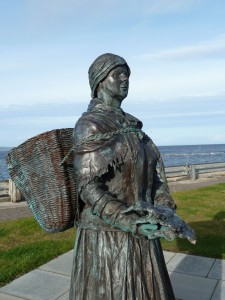 ….Rise up in the morning wi’ your bundles in your hand,
….Rise up in the morning wi’ your bundles in your hand,
Be at the station early or you’ll surely hae to stand,
Tak’ plenty to eat and a kettle for your tea,
Or you’ll mebbe die of hunger on the way to Yarmouth quay…..
… It’s early in the morning and it’s late into the nicht,
Your hands a’ cut and chappit and they look an unco’ sicht,
And you greet like a wean when you put them in the bree,
And you wish you were a thoosand mile awa’ frae Yarmouth quay
There’s coopers there and curers there and buyers, canny chiels,
And lassies at the pickling and others at the creels,
And you’ll wish the fish had been a’ left in the sea
By the time you finish guttin’ herrin’ on the Yarmouth quay…..
Bha mo sheanmhair na caileag-sgadain na h-òige. Bhiodh i a’ cutadh nan sgadan aig na “farlans” fad an latha, le pìosan annairt mu na corragan, no a’ pacadh nam baraillean, agus a rèir coltais bha mo sheanmhair glè mhath air na sgadain a phacadh, obair a bha gu math cruaidh.
Bha na caileagan-iasgaich gu trice bòidheach agus spaideil agus tha òrain romànsach ann cuideachd, mar The Bonnie Fisher Lassie:
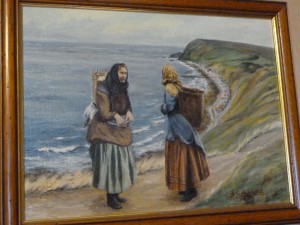 ….Her petticoats she wore so short, they came below her knee.
….Her petticoats she wore so short, they came below her knee.
Her handsome leg and ankle, they so delighted me.
Her rosy cheeks her yellow hair, for an empress she might pass,
And wi’ her creel she daily toiled, the bonnie fisher lass.
I stepped up beside her and to her I did say
‘Why are you out so early? Why are you going this way?’
She said ‘I’m going to look for bait, now allow me for to pass.
For our lines we must get ready’ said the bonnie fisher lass…..
Cha b’ e sin an fhreagairt a bu romànsaiche! Ach practaigeach agus fìor gu leòr.
Bha spòrs agus beagan saorsa aig na caileagain-sgadain cuideachd nuair a bha iad air falbh leis na caraidean aca, ged a bha an obair fhèin cho doirbh is sgìtheil, ach nuair a bha iad pòsta, dh’fhàs a h-uile rud fiù ‘s nas duilge. Mar a sheinn Ewan MacColl anns The Fisherman’s Wife:
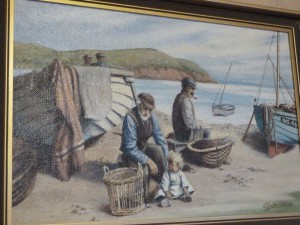 …Ye ken whit wye he has tae work
…Ye ken whit wye he has tae work
Ye ken the hours he has tae keep
And yet it maks ye angry when
Ye see him just come hame tae sleep
Through the months and through the years
While ye’re bringing up the bairns
Your man’s awa’ tae here and there
Followin’ the shoals of herrin’
And when he’s back there’s nets tae mend
Ye’ve maybe got a score or twa
And when they’re done he’ll rise and say
Wife, it’s time I was awa’….
Feumaidh gun do chuir e dragh mòr ort a bhith a’ feitheamh ris a’ bhàta, an dòchas gun tilleadh an duine agad gu sàbhailte. Uaireannan cha do thill, mar a chluinneas sinn anns an òran The Lifeboat:
… There’s sweethearts and wives standing round,
The boats crew are all from this town,
Such an earnest-like throng, such a silence among,
And we pray as the mercy-boat speeds on her way,
‘O dear Lord above, hear our cry.’
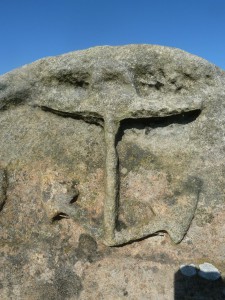 At length on that storm-wracked shore
At length on that storm-wracked shore
Our hands help the lifeboat to moor,
And we learn of the fate of the skipper and mate,
And the fishermen pray as they stand ‘neath the spray,
‘O Lord, help their wives to endure.
Lord, father their bairns in this hour.’…
Ach uaireannan eile bhiodh iad fòrtanach, mar a chluinneas sinn anns an òran Guiding Light and the Evening Star, air a dhèanamh le Scott Murray (mòran taing!) a rèir sgeulachd a fhuair e bho bhoireannach ann an Cellardyke:
…And ye thocht on the man nearly lost
Wha was ta’en frae his boat by a wave
He was put back on deck by anither
An we thanked the Lord he was saved
Aye we thanked the Lord he was saved….
Mu dheireadh tha mi a’ dol a thoirt òran tradiseanta dhuibh a tha a’ glacadh suidheachadh teaghlachan iasgaich air leth math – The Peterheid Fisherman’s Wife. Tha dealbhan ann a chuir cuimhne orm air na a dh’innis mo mhàthair dhomh mun bheatha aca nuair a bha i òg, is an t-athair aice a’ dèanamh na tiopagan, na ‘cheepicks‘ no tippings, ri taobh an teine, agus na boireannaich a’ cruinneachadh a’ bhiathaidh air a’ chladach bho mhoch gu dubh. Seo an òran gu lèir dhuibh:
Fa wid be a fisherman’s wife
Tae work wi’ a tub an a scrubber an’ a knife
A deid oot fire an’ a raivel’d bed
An’ awa tae the mussels in the mornin.
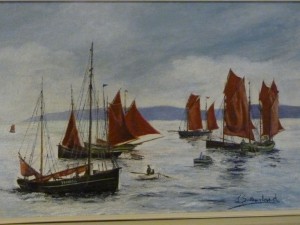 Chorus: Here we come scoorin in,
Chorus: Here we come scoorin in,
Three reefs tae the foresail in.
There’s nae a dry stick tae pit on wer back,
But still we’re aa teetotllers.
Noo, fa’ll gie’s a hand tae rin a ripper lead
Tae try for a coddie in the bay o’ Peterheid?
They’re maybe at the Lummies or the clock on Sautis’eid
Fen we gaun tae the sma lines in the mornin.
Ma puir aul father’s in the middle o’ the flair
Beatin heuks ontae tippets an they’re hingin on his chair.
They’re made wi horses’ hair, man, for that’s the best o’ gear
Tae be gyan tae the fishin in the mornin.
Syne it’s doon the Geddle Braes in the middle o’ the nicht
Wi an aul seerup tin an a can’le for a licht,
Tae gaither up the pullars, ev’ry een o’ them in sicht
So we’ll get the linie baited for the mornin.
It’s easy to the cobbler, sittin in his neuk,
His big copper kettle hingin on a crook.
But we’re in the boo and we cannae get a heuk
It’s sair hard work in the mornin.
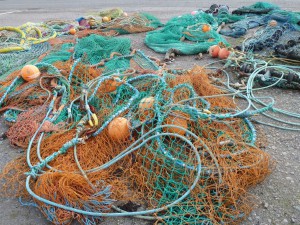 It’s nae the kin o’ life that a gentle quine can thole
It’s nae the kin o’ life that a gentle quine can thole
Wi her fingers reid raw wi the scrubbin oot a yole
An a littlen on her hip, she’s awa tae cairry coal,
She’ll be caaed sair deen in the mornin.
Still an aa she widnae change for the gran’est o’ yer gear
For she never kens the minute when her hairt’ll loup wi fear.
For he’s awa tae the sea an he’s aa that she has dear
She qued be a widow wi his bairn in the mornin.
*********************************************************
(For lyrics of songs named, see Gaelic version above)
When I was preparing a workshop on the fishing villages of the North East a couple of years ago (reported in the Seaboard News at the time), I was researching suitable songs and I noticed that there were a lot dealing with the hard life of the womenfolk, the wives or the herring-girls. Recently I was also talking to my mother about this after our visit to the East Neuk and especially the Anstruther fishing museum, with its displays and paintings showing the women at their backbreaking work.
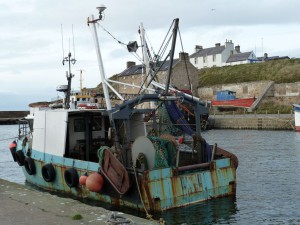 I wanted to share some of my favourites among these songs with you, as they’re part of our own heritage, with our Easter Ross fishing history and links with the other coastal towns, from the Highlands to Yarmouth. Fortunately for us, there are still people in our community who remember that way of life or who heard about it from their own parents. They’ll recognise many of the scenes and situations depicted here, and can certainly tell us even more.
I wanted to share some of my favourites among these songs with you, as they’re part of our own heritage, with our Easter Ross fishing history and links with the other coastal towns, from the Highlands to Yarmouth. Fortunately for us, there are still people in our community who remember that way of life or who heard about it from their own parents. They’ll recognise many of the scenes and situations depicted here, and can certainly tell us even more.
There are traditional songs and others written more recently but in the traditional style, such as those by Ewan MacColl. This one of his ‘classics’, composed for the BBC Radio programme ‘Singing the Fishing’ in 1960. It deals with the herring-girls who travelled from the Moray Firth to Yarmouth – Come a’ ye fisher lassies.
…And you’ll wish the fish had been a’ left in the sea..
My grandmother was a herring-girl in her youth. They would be gutting the herring at the ‘farlans’ all day, with strips of linen round their fingers to protect them, or packing the herring in barrels, and apparently my grandmother was very skilled at packing, an extremely demanding job.
The fishing girls were often very pretty and smartly turned out, so there are romantic songs too, like The Bonnie Fisher Lassie. But her answer to the gentleman is more practical than romantic –
She said ‘I’m going to look for bait, now allow me for to pass..’
The girls also had fun and an element of freedom when following the herring boats with their friends, hard though the work was, but when they got married, things got even harder, as Ewan MacColl sings in The Fisherman’s Wife.
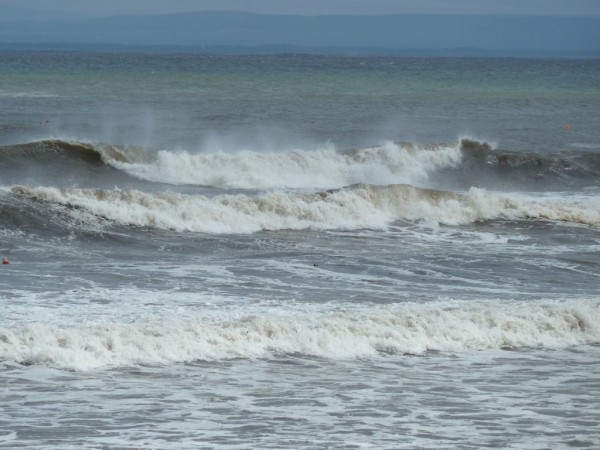 ..And when he’s back there’s nets to mend….
..And when he’s back there’s nets to mend….
It must have been very worrying, waiting for the boat, hoping that your man would return safely. Sometimes he didn’t, as we hear in the song The Lifeboat.
…and we learn of the fate of the skipper and mate…
But sometimes they were lucky, as in the song Guiding Light and the Evening Star, written by Scott Murray (thanks to him!) from a story told him by a lady in Cellardyke.
….Wha was taen frae his boat by a wave
He was put back on deck by anither…
Finally I have one more song for you that for me captures the situation of the fishing familes particularly well – The Peterheid Fisherman’s Wife. There are scenes that perfectly recall what my mother told me about their home life when she was young , her father spinning the horsehair ‘cheepicks’ or tippings by the fire, and the women gathering bait at all hours.
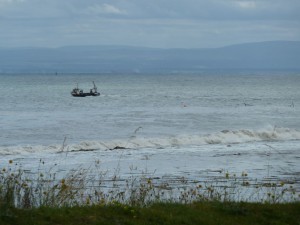 Fa wid be a fisherman’s wife
Fa wid be a fisherman’s wife
Tae work wi’ a tub an a scrubber an’ a knife
A deid oot fire an’ a raivel’d bed
An’ awa tae the mussels in the mornin…..
******************************************************************
Thanks to Anstruther museum for permission to use the herring girls painting, and to my mother for the other paintings.
Links to sources, lyrics and audio-links
Ewan MacColl lyrics: Come all ye fisher lassies (Song of the Fish-Gutters): http://www.traditionalmusic.co.uk/song-midis/Song_of_the_Fish-Gutters.htm
The Fisherman’s Wife (A the week…): http://www.traditionalmusic.co.uk/song-midis/Week_Your_Mans_Awa_or_Fishermans_Wife.htm
Scott Murray: Guiding Light and the Evening Star on the Sangsters CD Sharp and Sweet: http://www.footstompin.com/products/cds/sharp_and_sweet (the Cellardyke song from last month is also on that)
Traditional: The Bonnie Fisher Lassie: http://www.mervent.ru/lyrics/293-bonniefisherlass.html
The Lifeboat: http://mudcat.org/thread.cfm?threadid=138271
The Peterheid Fisherman’s Wife (Fa wid be..) : http://www.ltscotland.org.uk/scotlandssongs/secondary/genericcontent_tcm4572877.asp
Useful CDs: Isla St Clair: Tatties and Herrin – the Sea http://www.greentrax.com/music/artists/reviews/Isla-St-Clair-Tatties-And-Herrin-The-Sea-CD/
Ewan MacColl: Singing the Fishing http://www.amazon.co.uk/Singing-Fishing-MacColl-Charles-Parker/dp/B00000JG3V/ref=pd_rhf_p_t_3
Audio/video:
The late Ray Fisher and Cilla Fisher singing Come all ye fisher lassies: http://youtu.be/K0Aeety5IGg
Steeleye Span: The Fisherman’s Wife ( A’ the Week yer man’s awa’): http://www.youtube.com/watch?v=NRifQnoNL98
The Lochies: Shoals of Herring (in Gaelic, with archive pictures): http://youtu.be/EspRkEcfNHw
Duilleag fhiosrachail air làrach-lìn Fèisean nan Gàidheal – barrachd ri leughadh agus ri chluinntinn an sin. Is math as fhiach dhuibh tadhal air an làrach lìn gu lèir.
An informative page on the Fèisean nan Gàidheal website – more to read and to listen to over there. The whole site is well worth a visit!
http://www.feisean.org/en/gaelic-learning/
http://www.feisean.org/ga/ionnsachadh-na-gaidhlig/index.php
 Bidh an logo seo an-comhnaidh a’ ciallachadh rudeigin math!
Bidh an logo seo an-comhnaidh a’ ciallachadh rudeigin math!
This logo is always a sign of something good!
http://www.feisean.org/en/feisean/
Ionnsachadh na Gàidhlig
Gàidhlig – tè de chànain eachdraidheil na h-Alba. Tha a buaidh ri faicinn air feadh na dùthcha tro na linntean, gu h-àraid ann an ainmean-àite.
’S i a’ Ghàidhlig aon de chànain nàiseanta na h-Alba. Chithear agus cluinnear Gàidhlig an ìre mhath air feadh na h-Alba – bho Dhùn Èideann agus Glaschu gu na h-eileanan, air feadh taobh siar na dùthcha, suas don taobh a tuath gu Cataibh agus Gallaibh.
Chaidh Achd na Gàidhlig aontachadh ann an 2005, tha Sgoiltean Gàidhlig againn an àite Gàidhlig a bhith air a casg. Tha sianal ùr telebhisein againn – BBC ALBA. Tha saoghal ùr romhainn agus buinidh Gàidhlig ri Alba air fad.
Gaelic Learning
Gaelic is one of Scotland’s national languages and its historical influence is to be found throughout Scotland. But Gaelic is also a part of modern life in Scotland and recent research has shown strong public support for the retention and revitalisation of Gaelic…….
……Today, Gaelic speakers are spread throughout Scotland. Just over half live in the Highlands and Islands with just under half in the Lowland areas, and large concentrations in Greater Glasgow, Edinburgh, Inverness and Aberdeen.
There are Gaelic speakers worldwide, mainly through families emigrating for employment and historical reasons such as forced emigration. Gaelic is still spoken in Cape Breton in Canada where there is significant activity in education and the arts; there are also a significant number of people new to the language learning Gaelic in countries such as Germany, Spain, the Eastern European states and North America. Japanese scholars have also shown interest in Gaelic…….
…….Many young people are educated through Gaelic and there is a vibrant arts scene as well as a dedicated Gaelic service on radio and television through BBC ALBA.
Tha liosta abairtean feumail ann cuideachd, le putan leis an fhuimneachadh.
There’s also a lots of useful expressions with a button to click for audio.
E.g.
Slàinte Mhath! Good Health!
Cò às a tha thu? Where are you from?
Tha am biadh math/blasta The food is good/tasty
Dè tha seo a’ cosg? What is the cost of this?
Turas math dhut! Good journey to you (Bon Voyage)
An toil leat ceòl? Do you like music?
Am bu thoil leat deoch? Would you like a drink?
Bha Mìchael Bauer, aka Akerbeltz – deasaiche Dwelly air-loidhne agus Am Faclair Beag air loidhne, am fear a thug Firefox sa Ghàidhlig, dearbhadair litreachaidh Gàidhlig agus làraichean-lìn eile feumail, agus fiù ‘s geamannan eadar-lìn Gàidhlig dhuinn, a h-uile rud saor an-asgaidh – gu math trang am bliadhna.
Am Faclair Beag: http://www.faclair.com/
Dwelly air loidhne: http://www.dwelly.info/
Akerbeltz (gràmar amsaa): http://www.akerbeltz.org/beagangaidhlig/gramar/beagangramair.htm
Bathar-bog: http://www.foramnagaidhlig.net/index.php?page=116
Geamannan: http://www.foramnagaidhlig.net/index.php?page=38
 Anns an Earrach nochd Blas na Gàidhlig, leabhar mu fhuaimneachadh na Gàidhlig ach le mòran , mòran fiosrachaidh eile ann, agus air a sgrìobhadh ann an stoidhle a tha gu math fosgailte, eirmseach, uaireannan èibhinn. Tha faidhlichean-fuaim (nan ceudan!) air làrach-lìn sonraichte cuideachd, gus an cluinnear gach eisimpleir.
Anns an Earrach nochd Blas na Gàidhlig, leabhar mu fhuaimneachadh na Gàidhlig ach le mòran , mòran fiosrachaidh eile ann, agus air a sgrìobhadh ann an stoidhle a tha gu math fosgailte, eirmseach, uaireannan èibhinn. Tha faidhlichean-fuaim (nan ceudan!) air làrach-lìn sonraichte cuideachd, gus an cluinnear gach eisimpleir.
http://www.amazon.co.uk/Blas-G%C3%A0idhlig-Practical-Scottish-Pronunciation/dp/1907165002
 Agus a-nis bidh tionndadh ùr “pàipeir” Dwelly’s Illustrated Gaelic-English Dictionary ann a dh’aithghearr, air a dheasachadh le Mìcheal còir cuideachd, rud air an robh feum againn fad deicheadan. ‘S e tionndadh didseatach a th’ ann, mòran nas fhasa ri leughadh na na droch leth-bric le clò beag salach a bha ann gu ruige seo.
Agus a-nis bidh tionndadh ùr “pàipeir” Dwelly’s Illustrated Gaelic-English Dictionary ann a dh’aithghearr, air a dheasachadh le Mìcheal còir cuideachd, rud air an robh feum againn fad deicheadan. ‘S e tionndadh didseatach a th’ ann, mòran nas fhasa ri leughadh na na droch leth-bric le clò beag salach a bha ann gu ruige seo.
Tha adhbharan gu leòr ann a bhith taingeil do Mhìcheal! Thug e uiread saor an-asgaidh dhuinn ; tha an t-àm aige a-nis rudeigin a choisinn leis na leabhraichean ùra aige. Mholainn na h-obraichean seo dhuibh! http://www.amazon.co.uk/Illustrated-Gaelic-English-Dictionary-Akerbeltz/dp/1907165029/ref=sr_1_1?s=books&ie=UTF8&qid=1315789651&sr=1-1
***************************************************************
MIchael Bauer, aka Akerbeltz, is the man who gave us Dwelly online, Am Faclair Beag online, Firefox and other software in Gaelic, a Gaelic spell-check, even computer games in Gaelic – all free. He’s been very busy this year and produced two new, much needed-books, and I hope that with these he can finally earn some well-deserved money from his efforts for Gaelic .
His Blas na Gàidhlig, on Gaelic pronunciation (with hundreds of online soundfiles), is far more than a pronunciation book, covering grammar points like lenition and enough snippets of interesting history to understand why some things seem so strange. It’s written in an accessible, often witty style, and is already clearly set to become a standard work.
His new work is an up-to-date version of Dwelly’s famous Illustrated Gaelic-English Dictionary, and this new digitally-based edition (due out 30 Nov) will be much easier to read than the smudged, small-print ones going around, and incorporate some corrections and a new explanatory foreword.
I can recommend anything Michael does – he’s an enthusiast as well as a scholar, and this joy comes across clearly. I hope libraries and individuals round the word invest in these books – they won’t regret it!
An interview with Michael here: http://indigenoustweets.blogspot.com/2011/05/were-here-were-using-this-language.html
Taing mhòr do Mhìcheal!
Lèirmheas glè mhath air a’ chuirm-chiùil “Fèis Rois aig 25” ann an Inbhir Nis Là na Sàbaid sa chaidh / great review of last Sunday’s “Fèis Rois is 25” concert:
Fèis Rois aig 25: Freumhan is Gasan / Roots and Shoots
http://northings.com/2011/09/12/blas-2011-feis-rois-is-25-roots-and-shoots/
Dealbhan brèagha an seo / nice set of pictures: http://www.blas-festival.com/gailearaidh–gallery-2011.html
Gailearaidh: Fèis Rois is 25 – Roots and Shoots


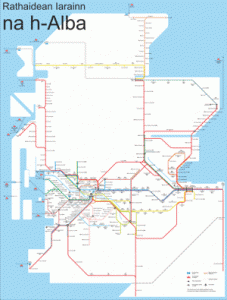 Obair sgoinneil le Pòl Caomhánach / Brilliant piece of work by Paul Kavanagh
Obair sgoinneil le Pòl Caomhánach / Brilliant piece of work by Paul Kavanagh
….bha dhìth orm ach clàr-dùthcha Gàidhlig de loidhnichean-rèile na h-Alba air fad, a’ sealltainn a h-uile stèisean san dùthaich.
Dh’ionnsaich mi le iongantas nach eil a leithid a’ mhapa ri fhaighinn sa Bheurla fhèin, gun luaidh air a’ Ghàidhlig no a’ Ghalldais. Gheibhear mapaichean prìomh-loidhneach, mapaichean sgìre-loidhneach agus mapaichean fo-bhailteach, ach chan fhaighear aon mhapa singilte sgeamàtach a sheallas a h-uile loidhne-rèile agus stèisein san dùthaich.
Mar sin chuir mi romham fear a chruthachadh agus a dh’fhoillseachadh saor is an asgaidh an seo air Newsnet. Ghabh mi mapa-rèile barraichte Srath Chluaidh, e-fhèin stèite air fear clasaigeach lìonra Fo-thalamh Lunnainn, agus leudaich mi e a-chum Alba gu lèir a chòmhdachadh. B’fheudar dhomh na slighean-rèile a chìthear a mhìneachadh ann an dòigh nas sìmplidh gu ìre, ach tha loidhnichean-rèile luchd-siubhail uile agus stèiseanan-trèana uile rim faicinn air a’ mhapa ùr seo. Rinn mi am mapa sa Bheurla, sa Ghàidhlig agus sa Bheurla Ghallda. ……
*******************************
…..A wis wantin a Gaelic cairte o aa o Scotland’s railwey lines, shawin aa the stations in the kintra.
Bit ti ma surprise A funn oot at sic a cairte isnae available in Inglish, nivver mind Gaelic or Scots. Ther cairtes o mainline routes, cairtes o regional routes an commuter routes, bit ther nae single schematic cairte at shaws aa the railwey lines an stations in the kintra.
Sae A pit ma mynd ti makin a cairte an tae pit it here on Newsnet whaur it’s free fur oniebuddie tae yuise. A tuik the braw railwey cairte o Strathclyde, itsel based on the classic 1931 design fur depictin the Lunnin Unnergroond netwark, an eikit ti it sae it kivvers the hale o Scotland. A haed tae mak the inter-city routes a tait mair semple, bit aa Scots passenger railwey lines an train stations is shawn on this new cairte. A’v duin the cairte in Inglish, Gaelic an Scots…..
***********************************
…..I wanted a Gaelic map of all of Scotland’s railway lines, showing all the stations in the country.
To my surprise I discovered that such a map isn’t available in English, never mind Gaelic or Scots. There are maps of mainline routes, maps of regional routes and commuter routes, but no single schematic map that shows all the railway lines and stations in the country.
So I decided to create one and to make it freely available here on Newsnet. I took the excellent railway map of Strathclyde, itself based upon the classic 1931 design for depicting the London Underground network, and extended it to cover the whole of Scotland. I had to simplify the routes shown somewhat, but all Scottish passenger railway lines and train stations are shown on this new map. I’ve done the map in English, Gaelic and Scots…..
RBS CommunityForce is a new initiative which sees us working with local communities to support the people, projects and charities making a real difference where you live.
Voting begins 26 September!
http://communityforce.rbs.co.uk/project/529
Gathering stories factual and folklore, songs, photographs, news cuttings etc relating to the Seaboard. Second phase will be to produce a book / dvd and link information to our www.seaboardvillages.com site. The Seaboard has a rich heritage.
The Seaboard Memorial Hall (SMH) is a community facility -it is the hub of the Seaboard Villages and since opening in 2002 it continues working towards sustainability whilst providing services such as training, social, leisure, recreational, secretarial, primary health care, job and tourist information etc.
Our elderly have amazing stories and photographs which need recording before its too late! Archiving and preserving this material in this way will be invaluable. The social history of these villages will be recorded in a way that people from all over the world with connections to the Seaboard may access and add to. The finished material will attract visitors to the area through the history of family connections, stories, photographs and folklore contained in the finished material.
Presently the Management Team have been encouraging people to submit material – however many are elderly and they need to be visited as much of their material is in their homes and they themselves are frail. Awarded funding would allow the SMH to administer the project and employ individuals to gather, record, transcribe, scan and archive material whilst up-dating the web-site.
Great interview with Niall Iain Macdonald here – on the challenge of a solo North Atlantic row, the charity (Scottish Mental Health) and the hopes and fears: http://www.breakingstrain.co.uk/2011/08/interview-with-niall-macdonald-solo-north-atlantic-rower/
and visit his page on Facebook for videos, photos, comments on his current gruelling training rows across the Minch here: https://www.facebook.com/pages/Ny2sy-Solo-North-Atlantic-Row-2012/208109105892826

And of course his main site for diary updates, background, donations etc etc:
http://www.ny2sy.co.uk/welcome
